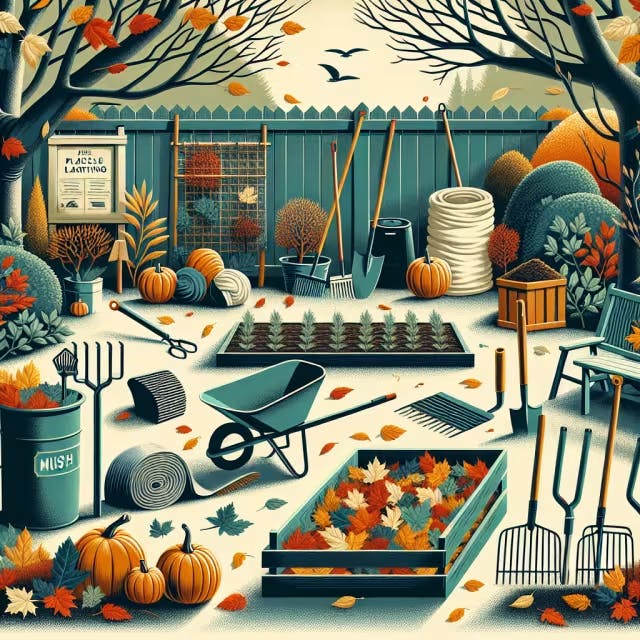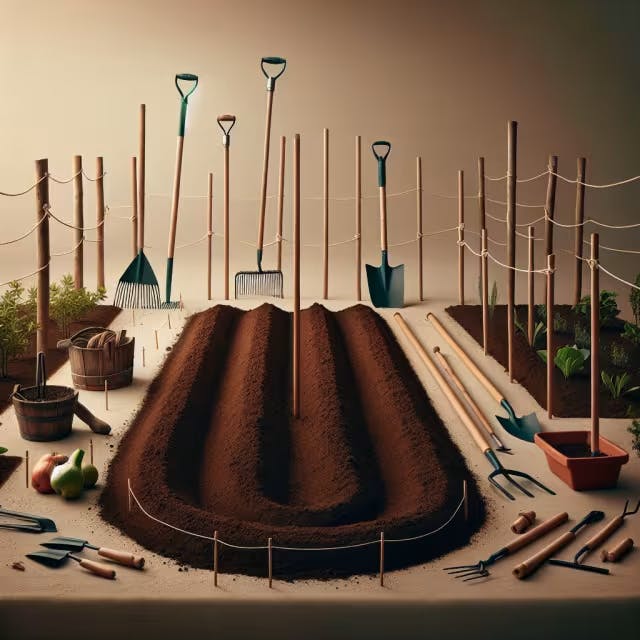Preparing Your Garden for Fall: Tips and Tricks
Go4Turf
February 12, 2024

As the allure of homegrown vegetables continues to captivate gardeners nationwide, the transition from summer to fall presents a unique set of challenges and opportunities for green thumbs. Preparing your garden for fall, with its tips and tricks, is not just about prolonging the bounty of your harvest but also ensuring your garden's vitality for the coming year. Whether you're working with sprawling raised beds, compact containers, or traditional in-ground plots, mastering the art of fall gardening will enrich both your table and gardening skills, making it an indispensable practice for anyone looking to maximize their vegetable production and gardening enjoyment.
Key Takeaways
Understanding your garden's unique needs during the fall transition is crucial for both immediate harvest benefits and long-term vitality.
Selecting the right plants tailored to your garden's specific fall conditions can significantly improve your gardening success.
Implementing essential fall garden maintenance practices is key to extending the harvest period and preparing for the next growing season.
Preparing the soil with appropriate amendments during fall lays the foundation for a thriving garden in the coming year.
Knowing how to protect your garden from early frost can save your harvest and allow for continued growth into the cooler months.

Understanding Your Garden's Fall Needs
As fall approaches, tailoring garden care to the season's demands ensures a healthy transition. Key activities include:
Mulching: Provide a protective layer to insulate plant roots from the cold. Choose straw, shredded leaves, or wood chips.
Watering: While less frequent than summer, ensure deep watering to support plants before the winter dormancy.
Soil Testing: Fall is ideal for soil testing, allowing time to adjust pH levels or nutrient content before spring planting.
Planting: Certain perennial plants and cool-season vegetables thrive when planted in fall, giving them a head start.
For those looking to delve deeper into garden health and plant growth, exploring essential gardening tips can provide valuable insights into sunlight, water, and nutritional needs.
Incorporating these practices prepares your garden for cooler days ahead, ensuring its vitality for the coming spring.

Choosing the Right Fall Plants for Your Garden
When selecting plants for your fall garden, consider adding a mix of perennials and annuals that thrive in cooler temperatures. Some excellent choices include:
Chrysanthemums: Known for their vibrant blooms and variety of colors, chrysanthemums can add a pop of color to your autumn garden.
Asters: With their starry-shaped flowers, asters are not only beautiful but also attract pollinators like bees and butterflies.
Ornamental Kale: For those looking for non-flowering options, ornamental kale provides interesting textures and colors that intensify as the weather cools.
Pansies: These hardy flowers can survive a frost, making them a perfect choice for extending the blooming season.
Incorporating these plants can enhance your garden's aesthetic and biodiversity. For additional guidance on plant health and growth, consider reading about essential gardening tips that can help even the most novice gardeners succeed.
Remember, a successful fall garden starts with the right plant selection. Combining flowering plants with foliage varieties can create a visually striking landscape that lasts well into the cooler months.

Essential Fall Garden Maintenance Tips
As fall approaches, ensuring your garden transitions smoothly into the colder months is imperative. Start by cleaning up debris to prevent the spread of disease and pests. This includes removing fallen leaves, spent flowers, and any diseased plants.
Key Tasks
Prune: Trim perennials back, focusing on those that have finished blooming or show signs of mildew and disease.
Mulch: Apply a fresh layer of mulch around plants to protect roots from frost and retain soil moisture.
Plant: Fall is the perfect time for planting spring-blooming bulbs and perennials due to the cooler temperatures and increased rainfall.
Task | Purpose | Timing |
Soil testing | Identify nutrient deficiencies and pH imbalance. | Early fall for accurate adjustments. |
Fertilization | Encourage root growth for stronger plants next spring. | Apply before the first frost. |
Lawn care | Aerate and overseed to ensure healthy growth. | Early to mid-fall for best results. |
Lastly, consider enhancing your soil's health by adding compost or manure. This replenishes nutrients lost during the summer growing season, ensuring your garden is primed for next year's growth.

Preparing Soil for Fall Planting
For a thriving fall garden, giving your soil the right prep is key. Start by removing weeds and debris to clear the way for new plantings. Incorporate a generous layer of compost to enrich the soil with essential nutrients. Testing soil pH helps identify necessary adjustments for optimal plant health. A balanced pH ensures plants can effectively absorb nutrients.
Aerate compacted soil to improve water and nutrient flow, essential for strong root development. Protect your soil and newly planted seeds from early frost with a layer of mulch. It conserves moisture, regulates temperature, and suppresses weed growth, making your garden less labor-intensive.
For specific plant requirements, such as those for lemongrass, ensuring they root in well-draining soil is crucial for lush growth. Remember, thriving plants start with healthy soil, so give your garden the foundation it needs this fall.

Protecting Your Garden from Early Frost
Keeping your garden thriving through the fall requires a proactive approach, especially when early frosts are a concern. Covering sensitive plants with frost cloths or burlap can provide essential protection on chilly nights. These materials let in light and air, ensuring your plants don't suffocate while keeping them warm. Another effective strategy is to use buckets or plant pots as makeshift shields against the frost, easily removed when temperatures rise during the day.
Mulching is also pivotal. Applying a thick layer of organic mulch around your plants can help retain soil warmth and moisture, offering an additional layer of insulation. For more detailed gardening insights, this article covers essential tips for overall plant health and growth, even in challenging conditions.
Watering your plants in the evening before a frost is forecasted can also be beneficial. Surprisingly, wet soil retains heat better than dry soil, providing a warmer environment for plant roots. Remember, the objective is to mitigate the cold's impact, not eliminate it entirely, ensuring your garden remains resilient and vibrant as seasons change. By focusing on mulching, appropriate fall plant selection, and soil preparation, you can adeptly transform your garden for the cooler months ahead. Employing these tips and tricks for preparing your garden for fall ensures a seamless transition, safeguarding plant health and promoting continuous growth. Remember, the key to a thriving fall garden lies in understanding its needs, choosing the right plants, and protecting it from early frost, setting the stage for a vibrant outdoor space.
Frequently Asked Questions
What are the best mulching techniques to protect my garden during fall?
The best mulching techniques for fall garden protection involve applying a generous layer of organic material around your plants. Opt for straw, shredded leaves, or wood chips to provide a protective layer that insulates plant roots from the cold, helps retain soil moisture, and suppresses weed growth. Applying mulch after cleaning up garden debris and conducting a soil test ensures your garden is well-prepared for the cooler months. Not only does mulch conserve moisture and regulate soil temperature, but it also enriches the soil as it breaks down. Incorporate these practices during the fall for a garden that's resilient and ready for spring.
How can I ensure my garden is adequately watered before winter dormancy begins?
To ensure your garden is adequately watered before winter dormancy, it's important to focus on deep watering sessions. This helps roots absorb enough moisture to sustain plants through the colder months. Autumn watering should be less frequent than in summer, allowing the soil to dry slightly between sessions. Applying a fresh layer of mulch after watering can help retain soil moisture and protect plant roots from extreme cold. Additionally, integrating organic matter like compost into the soil can improve its structure, enhancing water retention and supporting plant health as they prepare for dormancy. Remember, the goal is to keep the soil moist but not waterlogged, as excessive moisture can lead to root rot and other diseases.
What types of plants should I consider adding to my fall garden for vibrant color and biodiversity?
For a vibrant and biodiverse fall garden, consider adding a variety of plants that thrive in cooler temperatures. Some top choices include:
Chrysanthemums: These are excellent for adding color with their wide range of vibrant blooms.
Asters: Attractive to pollinators, they contribute to garden biodiversity with their starry-shaped flowers.
Ornamental Kale: Offers unique textures and colors that become more intense with cooler weather.
Pansies: Hardy flowers that can withstand frost, extending the bloom season into the cooler months.
Incorporating these plants not only enhances the garden's aesthetics but also supports a healthy ecosystem by attracting pollinators. Complementing these with practices such as mulching and proper soil care ensures a thriving garden ready to transition into winter.
How do I prepare the soil in my garden for successful fall planting?
To prepare your garden soil for successful fall planting, start by removing weeds and debris, then enrich the soil with compost to replenish nutrients. Conduct a soil pH test to determine if adjustments are needed for optimal plant nutrient uptake. Aerating the soil can improve oxygen, water, and nutrient flow, benefiting root development. Apply a protective layer of mulch around new plantings and existing plants to conserve moisture, regulate soil temperature, and reduce weed growth. Consider incorporating specific plant choices like chrysanthemums, asters, ornamental kale, and pansies that thrive in cooler temperatures. For a healthy transition into colder months, it's also crucial to clean up garden debris, prune perennials, and add compost or manure to enhance soil health.
What strategies can I employ to protect my plants from early frost and chilly nights?
To protect plants from early frost and chilly nights, consider the following strategies:
Cover plants: Utilize frost cloths or burlap on chilly nights to shield plants. These materials permit light and air flow while keeping plants warm.
Mulch: Apply a thick layer of organic mulch around plants for soil warmth and moisture retention, offering extra insulation.
Water in the evening: Watering plants before a frost can help, as wet soil retains heat better than dry soil, creating a warmer root environment.
Ensure to remove coverings like buckets or cloths during the day to prevent overheating. For a comprehensive understanding of plant care, including dealing with challenging conditions, detailed gardening insights are available in this article.